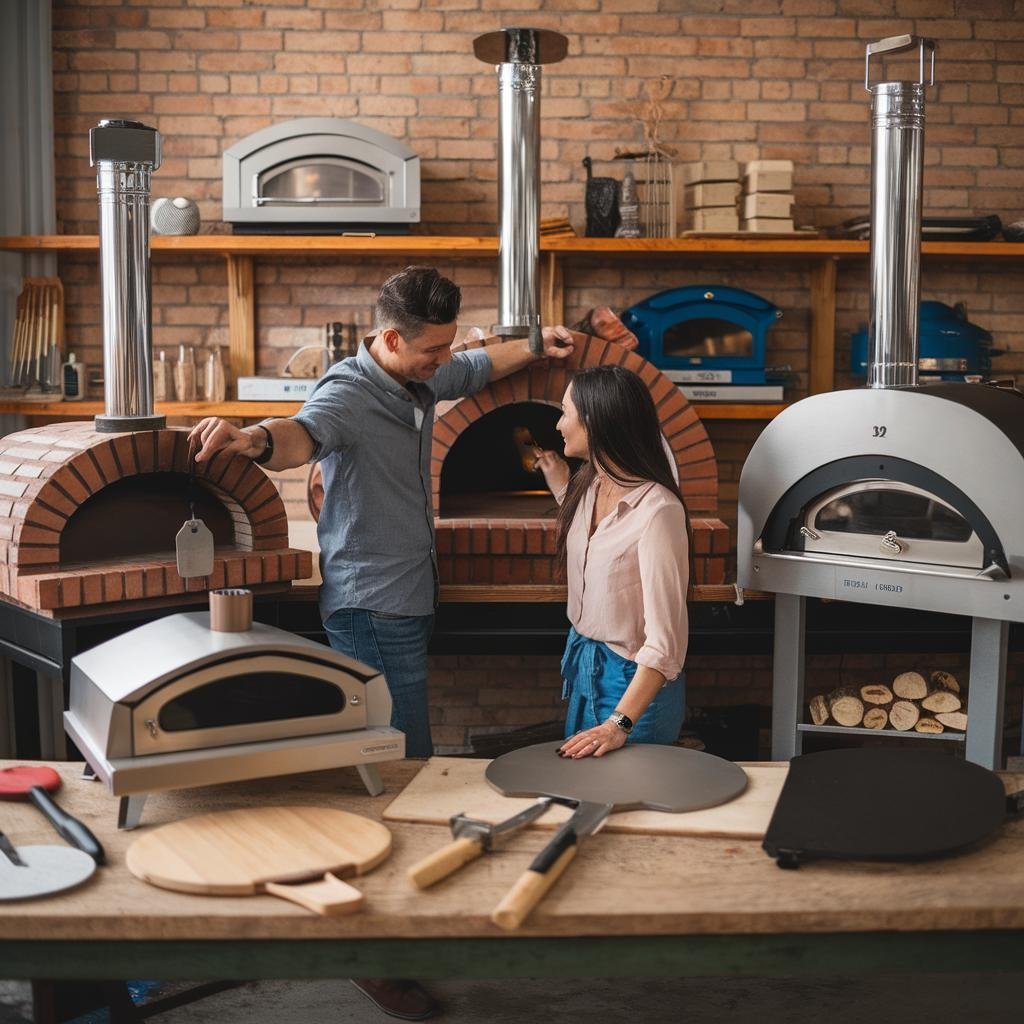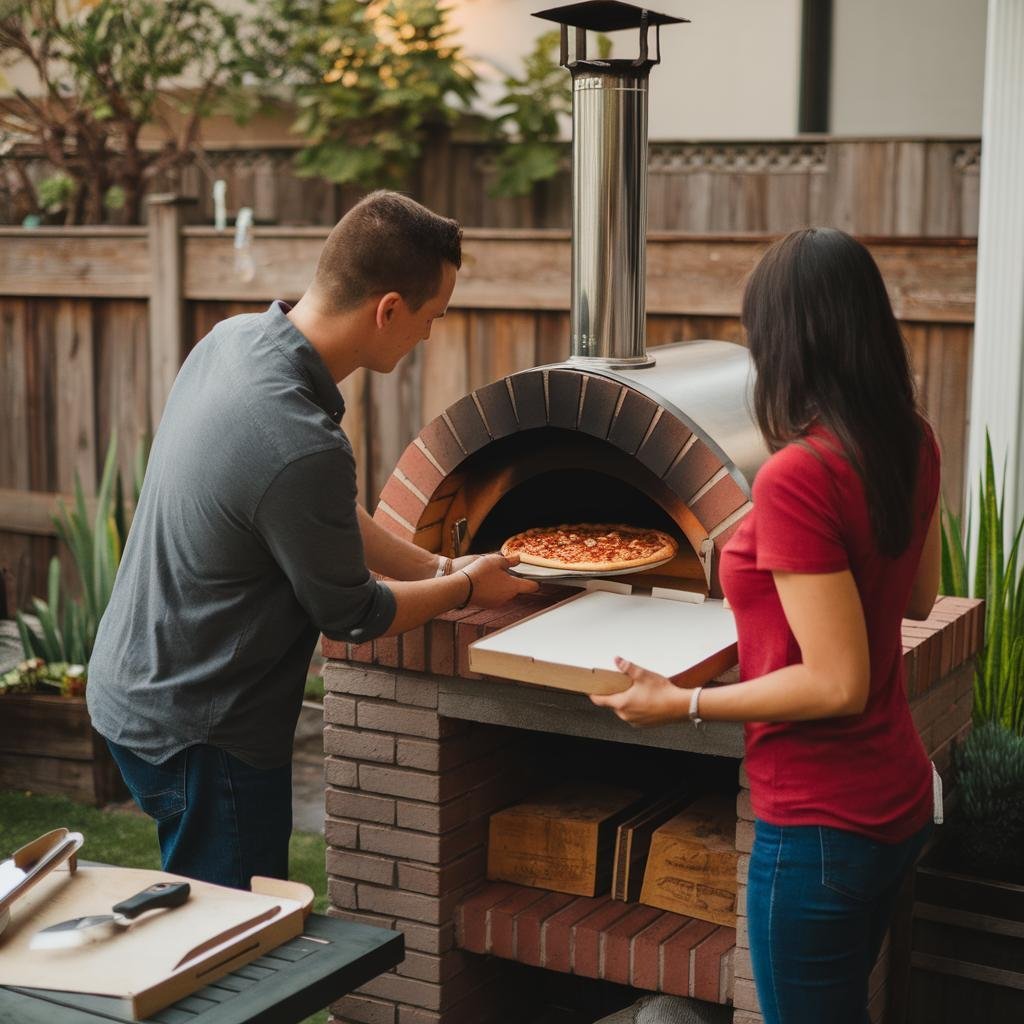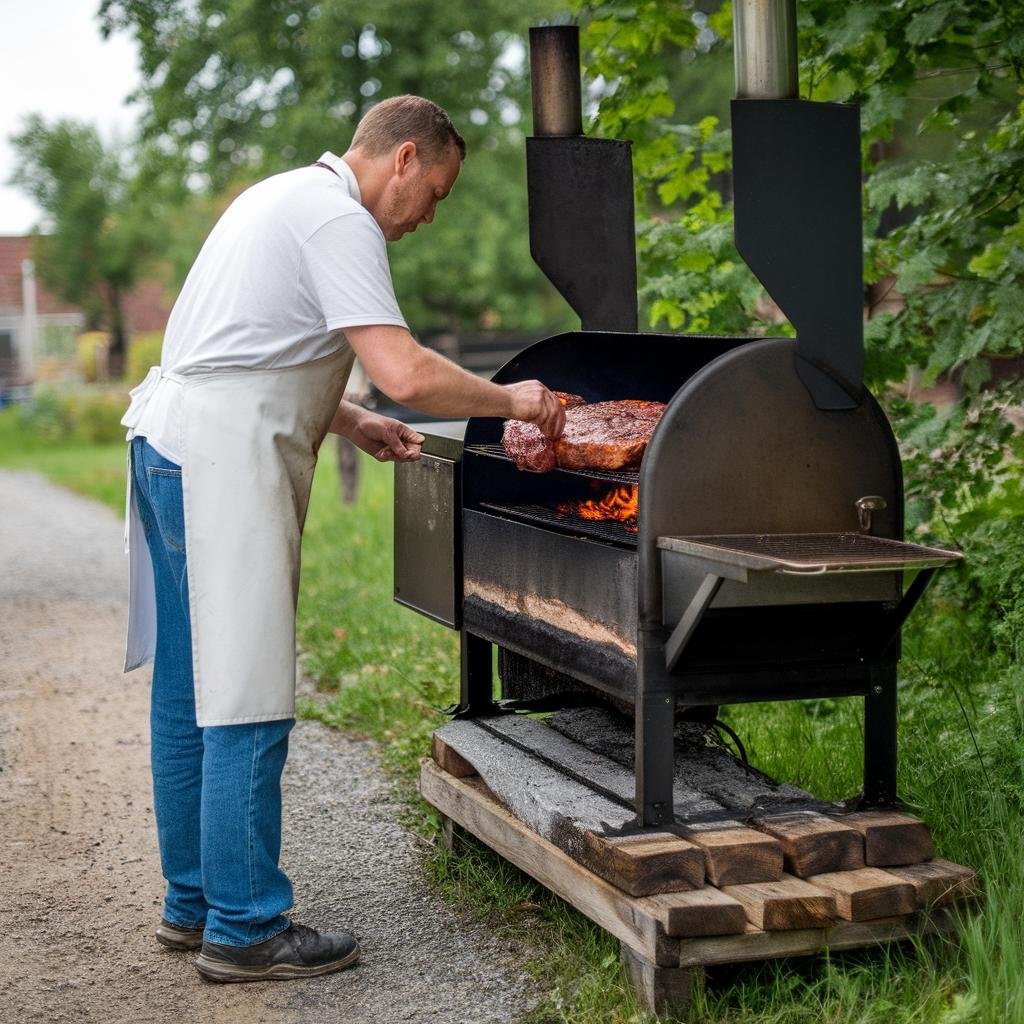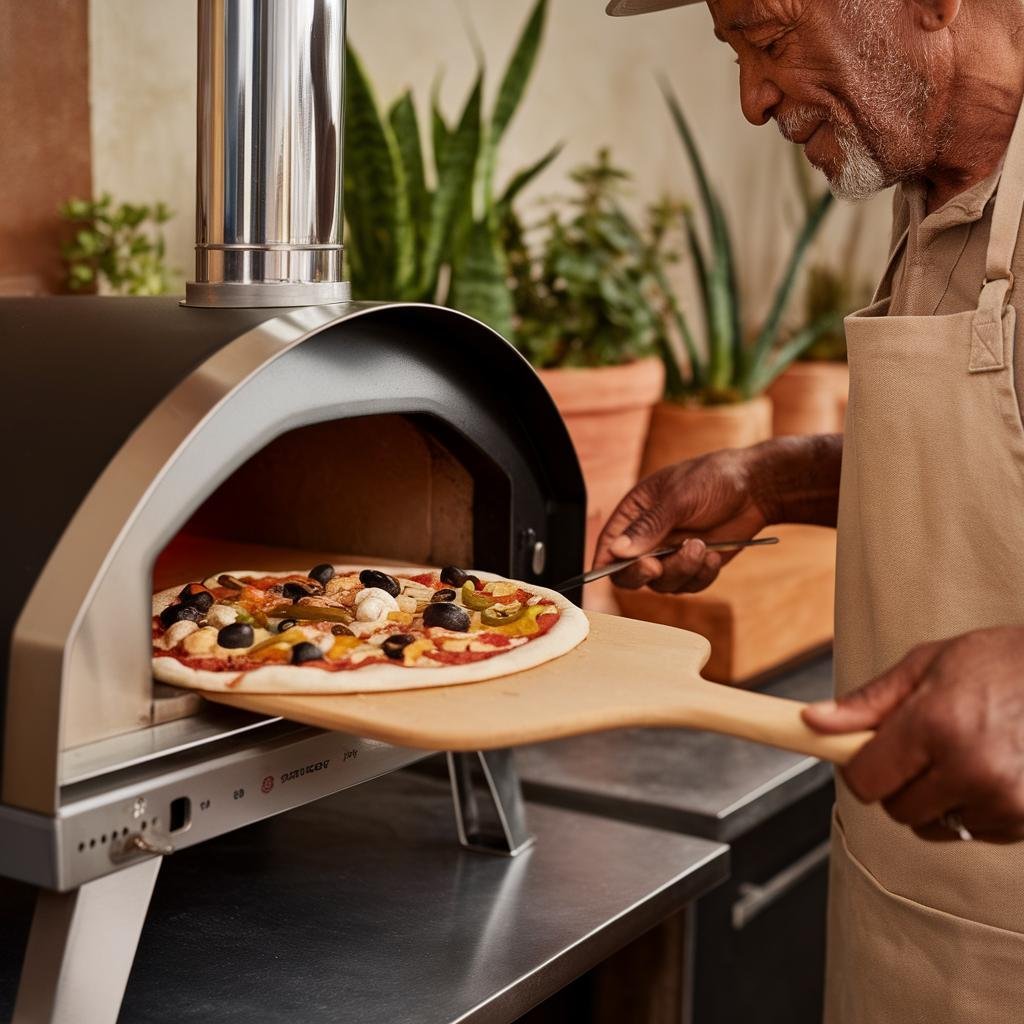Disclosure: This Post Contains Affiliate Links; We earn a commission on purchases.
Welcome to the exciting realm of pizza ovens! If you’re a pizza lover like us, you’ll be delighted to dive into the diverse world of pizza ovens, where each type offers unique features and cooking methods. Whether you’re a home cook who wants to recreate the taste of an authentic pizzeria or a restaurant owner looking for the perfect high-volume solution, understanding the different options available is crucial.
From traditional wood-fired ovens that infuse pizzas with smoky flavors to modern electric and gas ovens that offer convenience and precise temperature control, there’s a pizza oven for every taste and requirement. By exploring the various types and features of pizza ovens, you’ll gain valuable insights to help you make well-informed decisions.
Key Takeaways:
- Pizza ovens come in various types, each offering unique features and cooking methods.
- Wood-fired ovens provide authentic and flavorful pizzas, while electric and gas ovens offer convenience and temperature control.
- Understanding the different options available will help you choose the right pizza oven for your needs.
- Consider factors such as cooking capacity, temperature control, heat distribution, and budget when selecting a pizza oven.
- Stay tuned as we explore commercial pizza ovens, the working principles behind pizza oven functionality, and much more!
Commercial Pizza Oven: A High-Volume Solution
A commercial pizza oven is the powerhouse behind delivering delicious, piping-hot pizzas to the masses. Designed for high-volume production in pizzerias, restaurants, and food establishments, these specialized cooking appliances ensure efficient and consistent results. Let’s explore the world of commercial pizza ovens, their types, working principles, and costs.
Types of Commercial Pizza Ovens:
Commercial pizza ovens come in various types to suit different cooking preferences and production needs. Here are some popular options:
- Conveyor Pizza Oven: This type of oven features a conveyor belt that carries pizzas through a heated chamber, ensuring even cooking and fast production.
- Deck Pizza Oven: These ovens have stone or brick decks that radiate heat, creating the perfect crispy crust and authentic flavor.
- Convection Pizza Oven: Utilizing fans to circulate hot air, convection ovens provide efficient and consistent cooking results, ideal for high-demand settings.
Each type of commercial pizza oven has its unique benefits, making it crucial for businesses to choose the right one based on their specific needs.
How Commercial Pizza Ovens Work:
A commercial pizza oven employs high temperatures and precise heat control to cook pizzas quickly and evenly. These ovens often utilize gas, electricity, or a combination of both as the power source. Gas ovens offer rapid heat-up times, excellent temperature control, and energy efficiency. Electric ovens, on the other hand, provide precise temperature settings, making them ideal for consistent results and inexperienced operators.
Cost Considerations:
The cost of a commercial pizza oven can vary depending on the type, size, and features. While conveyor ovens tend to be more expensive due to their advanced technology, deck ovens offer a more affordable option with excellent performance. It’s essential for businesses to carefully assess their budget and consider the long-term benefits and ROI when investing in a commercial pizza oven.
Now that we have explored the world of commercial pizza ovens, let’s move on to understanding the working principles of these incredible cooking appliances in the next section.
How Does a Pizza Oven Work?
Understanding the working principle of a pizza oven is essential for achieving the perfect pizza. Whether you prefer the traditional charm of a wood-fired oven, the convenience of an electric oven, or the precision of a gas oven, each type operates on specific principles to deliver exceptional results.
Wood-fired Pizza Oven: Wood-fired ovens have been used for centuries and are renowned for their ability to produce authentic, flavorful pizzas. These ovens work by harnessing the power of intense heat generated by a wood fire. The fire heats up the oven chamber, creating a radiant heat source that cooks the pizza quickly and evenly. The porous structure of the oven walls also absorbs excess moisture from the dough, resulting in a crispy crust with a delicious smoky flavor.
Electric Pizza Oven: Electric pizza ovens offer convenience and precise temperature control. These ovens rely on electric heating elements to generate heat. They come equipped with heating elements at the top and bottom, ensuring even distribution of heat throughout the oven. The temperature can be easily adjusted to achieve the desired cooking conditions, making electric pizza ovens ideal for consistent and efficient pizza production.
Gas Pizza Oven: Gas pizza ovens combine the convenience of electric ovens with the intense heat of wood-fired ovens. These ovens use gas burners as a heat source, providing instant and controllable heat. The burners are strategically placed to ensure efficient heat distribution, resulting in well-baked pizzas with a crispy crust and evenly melted cheese. Gas ovens are popular in commercial settings where high volume and quick turnaround times are essential.
Each type of pizza oven offers its own unique features, allowing you to choose the one that best suits your needs and preferences. Whether you value tradition, convenience, or precision, there is a pizza oven for everyone.
The Benefits of Different Pizza Oven Types:
When deciding on the type of pizza oven to use, it’s important to consider the benefits that each type offers:
- Wood-fired Pizza Oven:
- Delivers authentic and smoky flavors
- Creates a crisp and charred crust
- Enhances the overall pizza experience
- Electric Pizza Oven:
- Offers precise temperature control
- Allows for consistent cooking results
- Easy to operate and maintain
- Gas Pizza Oven:
- Provides instant and controllable heat
- Efficient for high-volume production
- Offers versatility in cooking different types of pizzas
The image above provides a visual representation of the working principle of a pizza oven, highlighting the key elements and components involved in each type of oven.
Types of Pizza Ovens: From Brick to Countertop
When it comes to pizza ovens, there is a diverse range of options available, each with its own unique advantages and features. From the traditional brick ovens to the modern countertop models, understanding the different types of pizza ovens is crucial in selecting the perfect one for your needs. In this section, we will explore the various types of pizza ovens and delve into the key components, power sources, temperature ranges, cooking times, footprints, and the types of pizzas each oven excels at cooking.
Brick Pizza Oven
A brick pizza oven is a classic choice for pizza lovers who appreciate the authentic taste and charm of wood-fired cooking. These ovens are typically made of firebrick materials that retain and distribute heat evenly, resulting in a crispy and flavorful pizza crust. They are versatile and suitable for baking other dishes like bread and roasted meats.
Conveyor Pizza Oven
For high-volume pizza production, conveyor pizza ovens are a popular choice in commercial settings. These ovens use a conveyor belt system to move the pizzas through the cooking chamber, ensuring consistent and rapid cooking. Perfect for busy pizzerias and restaurants, conveyor ovens offer efficiency, speed, and precise temperature control.
Deck Pizza Oven
A deck pizza oven mimics the traditional brick oven cooking method but with added convenience. These ovens have multiple baking chambers or decks made of refractory materials, allowing you to bake multiple pizzas simultaneously. Each deck can be individually controlled, providing flexibility and consistency in cooking different types of pizzas.
Convection Pizza Oven
Convection pizza ovens use a fan or multiple fans to circulate hot air evenly throughout the cooking chamber. This technology ensures quick and even cooking while maintaining the desired crispiness. Convection ovens can be powered by electricity or gas, making them suitable for both commercial and residential use.
Countertop Pizza Oven
If space is a concern, countertop pizza ovens are a great option. These compact ovens are designed to fit on your kitchen counter, making them ideal for home use or small restaurants. Despite their size, countertop ovens offer powerful heating elements and temperature control, allowing you to bake delicious pizzas with ease.
“Each type of pizza oven offers its own benefits and features, so it’s important to consider your cooking preferences, space availability, and intended usage to choose the perfect pizza oven that suits your needs.”
The following table provides a summary of the key features and characteristics of each type of pizza oven:
| Pizza Oven Type | Key Features | Power Source | Temperature Range | Cooking Time | Footprint | Ideal Pizzas |
|---|---|---|---|---|---|---|
| Brick Pizza Oven | Authentic wood-fired cooking | Wood, gas | From 700°F (371°C) to over 1000°F (538°C) | 2-5 minutes | Large | Neapolitan, thin-crust |
| Conveyor Pizza Oven | High-volume production, consistent cooking | Electric, gas | 250°F (121°C) to 600°F (316°C) | 5-10 minutes | Large | Large and thick-crust |
| Deck Pizza Oven | Multiple baking chambers, versatile | Wood, gas, electric | From 350°F (177°C) to over 900°F (482°C) | 2-8 minutes per pizza | Medium to large | Various types |
| Convection Pizza Oven | Rapid and even cooking | Electric, gas | 200°F (93°C) to 550°F (288°C) | 7-15 minutes | Small to medium | All types |
| Countertop Pizza Oven | Compact, convenient, and versatile | Electric | From 400°F (204°C) to 700°F (371°C) | 10-15 minutes | Small | All types |
When selecting a pizza oven, consider the features that align with your cooking goals and the available space in your kitchen or restaurant. Ultimately, finding the perfect pizza oven will enhance your culinary experience and allow you to create delicious pizzas with ease.
How to Install and Maintain a Pizza Oven?
Installing a pizza oven requires careful planning and execution. Follow these key steps to ensure a successful pizza oven installation:
- Choose the Right Location: Select a suitable area for your pizza oven installation, considering factors such as accessibility, safety, and space requirements. Ensure there is enough room for the oven, ventilation, and any additional equipment.
- Prepare the Foundation: Create a stable and level foundation for the pizza oven. This may involve pouring a concrete slab or constructing a base using heat-resistant materials, depending on the type of oven.
- Arrange Electrical and Gas Connections: If your pizza oven operates on electricity or gas, enlist the help of professionals to ensure proper installation of electrical wiring or gas lines. Safety is paramount when dealing with these utilities.
- Assemble and Position the Oven: Follow the manufacturer’s instructions to assemble the pizza oven and place it on the prepared foundation. Make sure it is secure and stable.
- Ventilation and Insulation: Install appropriate ventilation to ensure the oven operates efficiently and safely. Insulate the oven to retain heat and prevent external surfaces from becoming dangerously hot.
- Fuel Source: Depending on the type of oven, establish a suitable fuel source. Wood-fired ovens require a stockpile of firewood, while electric and gas ovens need access to their respective power sources.
Maintaining and cleaning your pizza oven is essential for its longevity and optimal performance. Follow these tips to ensure your pizza oven remains in top condition:
- Regular Cleaning: Clean the interior and exterior surfaces of the oven regularly to remove any food residue or grease buildup. Use a soft brush and warm water or a mild cleaning solution recommended by the manufacturer.
- Inspect and Repair: Periodically inspect the oven for any signs of damage or wear. Address any issues promptly to prevent further deterioration and ensure safe operation.
- Deep Cleaning: Schedule occasional deep cleaning sessions to thoroughly remove stubborn stains or debris. Consult the oven’s manual or seek professional help for best practices.
- Protective Covers: Consider investing in protective covers to shield the oven from harsh weather conditions when not in use. This can prevent unnecessary damage and prolong its lifespan.
By following these installation and maintenance practices, you can enjoy delicious pizzas from your oven for years to come.
Testimonial: Expert Tips for Pizza Oven Maintenance
“Regular maintenance is crucial for preserving the performance and longevity of your pizza oven. Ensure proper cleaning to prevent any flavor transfer between pizzas and maintain consistent cooking results. Take the time to inspect your oven, addressing any issues immediately to avoid costly repairs in the future. And remember, always follow the manufacturer’s guidelines for cleaning, maintenance, and any necessary repairs.”
Choosing the Best Pizza Oven: Factors to Consider
When it comes to selecting the perfect pizza oven for your needs, there are several important factors to take into consideration. By understanding these factors, you can make an informed decision and find the best commercial pizza oven that meets your requirements. Let’s explore the key considerations:
Oven Type
The first thing to consider is the type of pizza oven that best suits your cooking style. There are various options available, including brick ovens, conveyor ovens, deck ovens, convection ovens, and countertop ovens. Each type has its own unique advantages and features, so it’s important to assess which one aligns with your preferences and cooking requirements.
Cooking Capacity
Next, determine the cooking capacity you need. Consider the volume of pizzas you plan to produce and the size of your establishment. Commercial pizza ovens have different capacities, ranging from small countertop models to large, high-volume ovens. Take into account your target customer base and the expected demand for your pizzas.
Temperature Control and Heat Distribution
Temperature control and even heat distribution are crucial for achieving consistent and delicious pizza results. Look for pizza ovens that offer precise temperature controls and efficient heat distribution mechanisms. This will ensure that your pizzas are cooked evenly, with the perfect balance of crispy crust and well-cooked toppings.
Cooking Versatility
Consider the versatility of the pizza oven in terms of the variety of dishes it can cook. Some commercial pizza ovens offer additional features like adjustable racks, multiple cooking modes, and the ability to cook a wide range of other foods besides pizza. This versatility can expand your menu options and maximize the utilization of your oven.
Construction Materials
Look for pizza ovens constructed with durable and high-quality materials. Stainless steel is a popular choice for commercial ovens as it offers durability, heat retention, and ease of cleaning. Ensure that the oven is built to withstand the demands of a busy commercial kitchen environment.
Budget
Finally, establish your budget for your pizza oven purchase. Consider the upfront cost, as well as any long-term maintenance or operational costs. Remember that a higher price tag doesn’t always equate to the best oven for your needs. It’s essential to find the right balance between cost and quality.
To further assist you in your decision-making process, here are some popular pizza oven brands that you may consider:
- PizzaMaster
- Bakers Pride
- Marsal and Sons
- Blodgett
- XLT Ovens
Customer reviews can also provide valuable insights into the performance and reliability of different pizza oven models. Take the time to read reviews and gather feedback from other pizza oven users to gain a better understanding of the options available.
By considering all these factors and conducting thorough research, you can confidently choose the best pizza oven that meets your needs and delivers mouthwatering pizzas to your customers.
Conclusion
The history of pizza ovens showcases an incredible evolution, transforming the art of pizza-making throughout the centuries. From ancient civilizations using simple wood-fired hearths to the modern innovations of electric and gas ovens, pizza ovens have been instrumental in creating the perfect slice.
The early wood-fired ovens, with their distinctive smoky flavors and crispy crusts, set the foundation for pizza as we know it today. As technology advanced, new methods of pizza oven cooking emerged, providing faster cooking times and enhanced temperature control. The introduction of electric and gas ovens allowed for increased efficiency and convenience, catering to the growing demand for pizza in commercial settings.
Looking ahead, the future of pizza oven technology holds even more exciting possibilities. With advancements in materials, smart technology integration, and sustainable energy sources, pizza ovens are poised to become even more efficient and eco-friendly. These innovations will undoubtedly continue to elevate the pizza-making experience, ensuring that pizza lovers around the world can enjoy their favorite dish for many years to come.
Source Links
- https://partsfe.com/blog/post/how-to-choose-best-commercial-pizza-oven
- https://www.linkedin.com/pulse/ultimate-guide-choosing-perfect-pizza-oven-hidayat-ullah?trk=article-ssr-frontend-pulse_more-articles_related-content-card
- https://pizzaexpert.mk/en/a-brief-history-of-pizza-ovens-from-ancient-hearth-to-modern-innovation/

Ryan Conlon is a BBQ enthusiast and inspired chef on a journey through the smoky, savory world of outdoor cooking. Hailing from the heart of the Midwest, Ryan’s passion for grilling ignited during his early years, where family gatherings often revolved around the sizzle of the grill and the aroma of seasoned meats.







